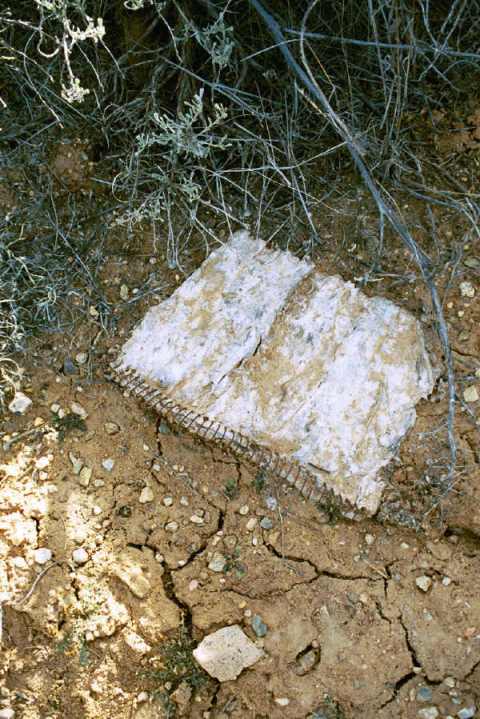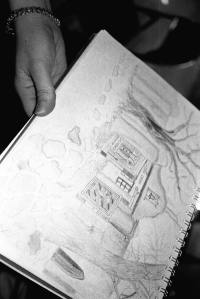–Ancient Text, on the Mesa, Taos, New Mexico, January 2003, Kodak C-41 negative print by QuoinMonkey, © 2003, all rights reserved
I used to shoot one photo at a time with a solid, black bodied, manual Minolta: 5 lenses, 9 filters, and a viewfinder. The metal body was covered in hard, black cardboard that would later peel away with age.
To haul all this around, I carried a heavy, powder blue canvas bag with multiple packs of extra batteries, a hotshoe mount, dedicated flash (by no coincidence, the exact size of a shoe), and never fewer than ten 35mm film canisters strapped to my body. Cameras, lenses, film, and photo paper were expensive. Nothing was to be wasted.
Now I pick up my light, plastic, Canon digital, swing out the LCD monitor, try to make out the distant image through the sun’s midday glare, read the manual cover to cover to decipher symbols representing functions that can either do this, or that, and possibly my laundry, and take as many shots as I need to get the precise composition and depth of field I’m looking for.
I used to go to the darkroom and spend hours drenched in safelight red: developing and exposing negatives, moving sheets of FB (fiber-based) Ilford, Kodak, and Fuji paper between developer, stop, fix and two or three baths of rinse water. I would watch in wonder as black and white gelatin silver images rose to the surface as if by magic from the bottom of the gray troughs.
Then I’d throw the wet prints into the roll drum, wait for an hour while they rinsed, hang them to dry with wooden clothes pins or press them one by one through a heat drum dryer, then lay them between archival sheets of paper and tote them home.
Now I sit down beside my laptop, plug the white connector cord into the USB port which automatically pulls up the software I need to automatically download hundreds of photographs into predestined, neatly labeled folders of light and color. I can then print them, send them by email, view them as a slideshow, flick them across my screensaver, or do absolutely nothing with them. They take up virtually no space.
Virtual-ly. No space.
I used to spend hours writing in watermarked paper journals, choosing just the right tooth, texture, ink, and pen, and display them in neat rows on oak bookshelves. I’d go back now and then to read and touch and taste and smell how the paper had soaked up the odor of the place I was living in at the time I was writing on it. I would turn page after page and wonder at who I’d become.
Now I type everything into a plastic computer on a tone deaf keyboard at a speed that keeps up with my brain. Except when I’m doing writing practice by hand (by hand, now there’s an old phrase), or making a grocery list, or jotting down a quote I hear on NPR, Fisher Space Pen to ruled pocket notebook, while driving home from work.
I’ve been thinking about choices. Choices have consequences. I’ve been thinking about sketch books and journals since reading One Journal, Ten Thousand Journals and handmade photographic processes since I wrote the Pinhole photo piece. I spend so much time in front of the computer.
And then there I was the other night, wooden pew 6, in the heavy, ornate, 150-year-old church that is Plymouth Congregational on Franklin, listening to Mary Oliver during the question and answer session mouthing, “Computers are bad,” with that little impish smirk on her face.
Mary Oliver doesn’t own a computer. She writes her poems on paper, draft after draft. She said she likes having all the crossed out words in her hands, holding the creative process. Natalie Goldberg is another writer who doesn’t use the computer. She writes her books by hand in large spiral notebooks and then has her assistant type up the manuscripts.
It got me to thinking, how many other writers, photographers, and artists are still using the old-style methods of creating?
Photoshop? Or sandwiched negatives, gurgling vats of water, and darkroom collage. Microsoft Word? Or handmade paper journals, brisk, soft, and cool to the touch.
I’m not the only blogger writing about changes and choices. Fluent had a piece last week, To Laptop Or Not to Laptop…. and Starting Over had a post about 10 Things to Do Without Technology. These are topics worth exploring. Because the thing about paper processes, notebooks, darkrooms, paint, graphite, and canvas is that they ground us.
Creative people are noticing because we are losing our ground.
When I’m at the computer 24/7, I’m often spacey and stir-crazy by the end of the day. It’s so familiar to me, I barely notice anymore. But there are days when I want to jog 10 miles (I don’t jog), yell at the top of my lungs, or run down the street screaming, “Stop the insanity!”
Why does everything have to be fast and speedy? When did we begin to need everything instantly and become afraid to patiently wait? What happened to slow and steady wins the race?
I want to be more in my body. I want to choose paper, not plastic. But I love the speed, connectivity, and community I have found on the web. A person anywhere in the world can read this post. Does anyone still find that astounding?
I predict there will someday be psychologists going to grad school to specialize in abnormalities resulting from constant computer use: time spent in the head, no time in the body. Maybe there already are.
Tonight Liz and I are going over to the Fairgrounds to buy perennials, annuals, shrubs, and trees for our gardens. Friends School of Minnesota is having their yearly sale.
They say they prepare children to embrace life, learning, and community with hope, skill, understanding and creativity. They are committed to the Quaker values of peace, justice, simplicity and integrity. That’s something I can really get behind.
I hope they remember to teach the little ones that everything around them will move at the speed of light – and they’ve got to learn how to stand still, how to stand up, in the middle of a tornado.
I’m suddenly longing to turn off my cell phone, slip the Dell into hibernate, and dig my hands into rich, wormy dirt. I’m suddenly longing to turn off all the buzz, and walk outside where my feet can be firmly planted on the ground.
Saturday, May 12th, 2007

























